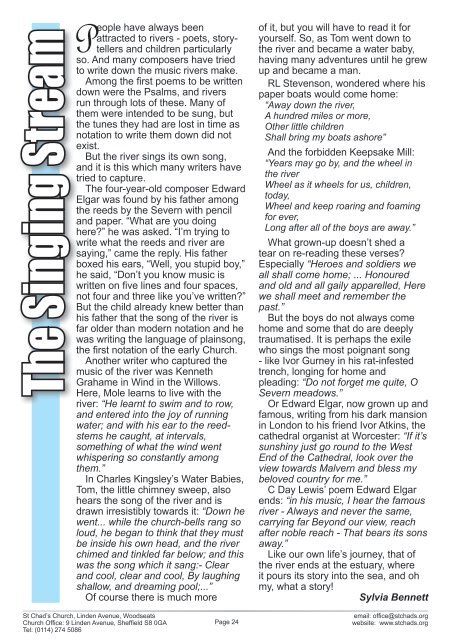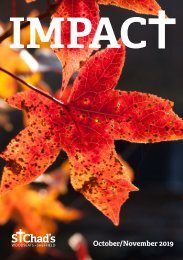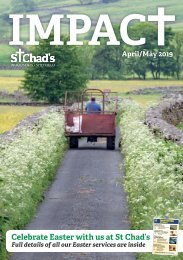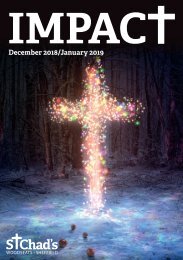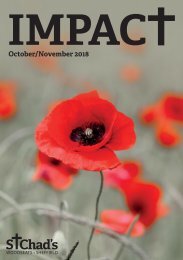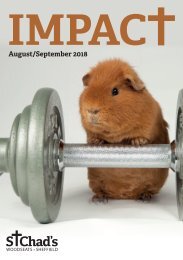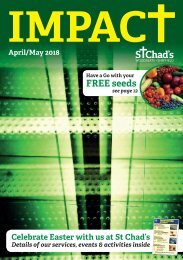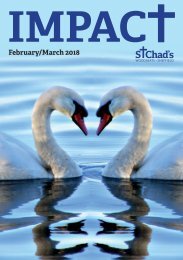Create successful ePaper yourself
Turn your PDF publications into a flip-book with our unique Google optimized e-Paper software.
The Singing Stream<br />
People have always been<br />
attracted to rivers - poets, storytellers<br />
and children particularly<br />
so. And many composers have tried<br />
to write down the music rivers make.<br />
Among the first poems to be written<br />
down were the Psalms, and rivers<br />
run through lots of these. Many of<br />
them were intended to be sung, but<br />
the tunes they had are lost in time as<br />
notation to write them down did not<br />
exist.<br />
But the river sings its own song,<br />
and it is this which many writers have<br />
tried to capture.<br />
The four-year-old composer Edward<br />
Elgar was found by his father among<br />
the reeds by the Severn with pencil<br />
and paper. “What are you doing<br />
here?” he was asked. “I’m trying to<br />
write what the reeds and river are<br />
saying,” came the reply. His father<br />
boxed his ears, “Well, you stupid boy,”<br />
he said, “Don’t you know music is<br />
written on five lines and four spaces,<br />
not four and three like you’ve written?”<br />
But the child already knew better than<br />
his father that the song of the river is<br />
far older than modern notation and he<br />
was writing the language of plainsong,<br />
the first notation of the early Church.<br />
Another writer who captured the<br />
music of the river was Kenneth<br />
Grahame in Wind in the Willows.<br />
Here, Mole learns to live with the<br />
river: “He learnt to swim and to row,<br />
and entered into the joy of running<br />
water; and with his ear to the reedstems<br />
he caught, at intervals,<br />
something of what the wind went<br />
whispering so constantly among<br />
them.”<br />
In Charles Kingsley’s Water Babies,<br />
Tom, the little chimney sweep, also<br />
hears the song of the river and is<br />
drawn irresistibly towards it: “Down he<br />
went... while the church-bells rang so<br />
loud, he began to think that they must<br />
be inside his own head, and the river<br />
chimed and tinkled far below; and this<br />
was the song which it sang:- Clear<br />
and cool, clear and cool, By laughing<br />
shallow, and dreaming pool;...”<br />
Of course there is much more<br />
of it, but you will have to read it for<br />
yourself. So, as Tom went down to<br />
the river and became a water baby,<br />
having many adventures until he grew<br />
up and became a man.<br />
RL Stevenson, wondered where his<br />
paper boats would come home:<br />
“Away down the river,<br />
A hundred miles or more,<br />
Other little children<br />
Shall bring my boats ashore”<br />
And the forbidden Keepsake Mill:<br />
“Years may go by, and the wheel in<br />
the river<br />
Wheel as it wheels for us, children,<br />
today,<br />
Wheel and keep roaring and foaming<br />
for ever,<br />
Long after all of the boys are away.”<br />
What grown-up doesn’t shed a<br />
tear on re-reading these verses?<br />
Especially “Heroes and soldiers we<br />
all shall come home; ... Honoured<br />
and old and all gaily apparelled, Here<br />
we shall meet and remember the<br />
past.”<br />
But the boys do not always come<br />
home and some that do are deeply<br />
traumatised. It is perhaps the exile<br />
who sings the most poignant song<br />
- like Ivor Gurney in his rat-infested<br />
trench, longing for home and<br />
pleading: “Do not forget me quite, O<br />
Severn meadows.”<br />
Or Edward Elgar, now grown up and<br />
famous, writing from his dark mansion<br />
in London to his friend Ivor Atkins, the<br />
cathedral organist at Worcester: “If it’s<br />
sunshiny just go round to the West<br />
End of the Cathedral, look over the<br />
view towards Malvern and bless my<br />
beloved country for me.”<br />
C Day Lewis’ poem Edward Elgar<br />
ends: “in his music, I hear the famous<br />
river - Always and never the same,<br />
carrying far Beyond our view, reach<br />
after noble reach - That bears its sons<br />
away.”<br />
Like our own life’s journey, that of<br />
the river ends at the estuary, where<br />
it pours its story into the sea, and oh<br />
my, what a story!<br />
Sylvia Bennett<br />
St Chad’s is not the only one to<br />
celebrate its centenary this year.<br />
So too is the Royal Society<br />
of Wildlife Trusts – a charity linking<br />
together 47 individual Wildlife Trusts<br />
with the aim of safeguarding wildlife<br />
and habitats throughout the UK. A<br />
hundred years ago it was formed<br />
as the Society for the Promotion<br />
of Nature Reserves, which marked<br />
the beginning of systematic nature<br />
conservation in our country.<br />
Along with British Waterways, the<br />
Wildlife Trusts are among the main<br />
national organisations responsible<br />
for protecting our rivers and streams,<br />
which provide vital habitats and<br />
food supplies for a diverse range of<br />
animals. We tend to take for granted<br />
mallard ducks and moorhens or<br />
coots, geese and sometimes swans.<br />
But these birds are only a few of the<br />
many species who live in or near<br />
rivers, or who rely on rivers for their<br />
food.<br />
Fish supported by our rivers include<br />
brown trout, eel, stickleback, pike,<br />
grayling, roach, perch and salmon.<br />
These fish also attract other fisheating<br />
predators, such as otters and<br />
herons. A kingfisher is a rare but<br />
delightful sight, skimming along the<br />
river course in a bright blue flash.<br />
The endearing little furry water vole<br />
is sadly an endangered species. One<br />
of the Wildlife Trusts’ projects is to<br />
provide homes for water voles.<br />
Even in upland areas, where<br />
streams can be pretty feeble unless<br />
there is heavy rain or melting snow,<br />
and not much in the way of nutrients,<br />
rivers still support insects such as<br />
mayflies and caddisflies, which<br />
provide food for salmon and brown<br />
trout and birds like dippers. In lowland<br />
areas, rivers tend to be richer in<br />
nutrients and so are able to support<br />
a wider range of species. Here, you<br />
might find chub, dace, roach, and<br />
other coarse fish, and even crayfish.<br />
The rate of flow doesn’t vary so<br />
much in lowland areas, so such parts<br />
provide a more stable habitat. But<br />
the benefit of waterways is that they<br />
act as ‘corridors’, which wildlife can<br />
use to move between fragmented<br />
habitats.<br />
The diversity of UK river habitats<br />
and wildlife is so great that this can<br />
be only a tiny snapshot of what is<br />
there. To discover more, a good<br />
starting point is the Wildlife Trusts’<br />
website (www.wildlifetrusts.org) or the<br />
feature on all sorts of different wildlife<br />
on the British Waterways website<br />
(www.waterscape.com/features-andarticles/features/wildlife).<br />
Amy Hole<br />
River Wildlife<br />
St Chad’s Church, Linden Avenue, Woodseats<br />
Church Office: 9 Linden Avenue, Sheffield S8 0GA<br />
Tel: (0114) 274 5086<br />
email: office@stchads.org<br />
St Chad’s Church, Linden Avenue, Woodseats<br />
Page 24 website: www.stchads.org<br />
Church Office: 9 Linden Avenue, Sheffield S8 0GA<br />
Page 25<br />
Tel: (0114) 274 5086<br />
email: office@stchads.org<br />
website: www.stchads.org


